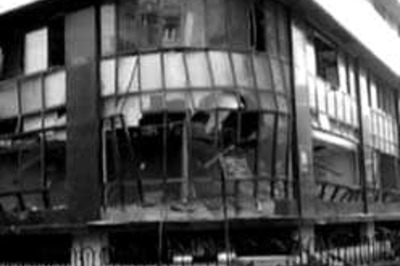
views
The Present
2022 is coming to an end and Kashmir has moved into Chillai Kalan (a 40-day-long period of harsh winter). As we enter the fourth year since the abrogation of the contentious Articles 370 and 35-A of the Indian Constitution that gave special status to the state of Jammu and Kashmir, it’s time to take stock of the current situation and what lies ahead.
There may be serious differences in opinion with regard to the abrogation of Articles 370 and 35-A. However, unlike in the past when all that the ruling political parties did was make hollow promises, there’s near unanimity that the present Union Territory (UT) administration has been serious in its outreach efforts, development-oriented initiatives and countering terror-linked threats.
Challenges
More than three decades of militancy has ruined Kashmir’s vibrant social, cultural and financial eco-system and requires immediate resuscitation. To undo this damage, Lt Governor, Manoj Sinha, has rightly stressed on “reworking priorities of development, initiating deep reforms in governance, curbing corruption, neutralising a well-fed terror ecosystem, the menace of drug addiction, and realising the dreams of Kashmiri youth.”
The Centre’s decision to take ‘baby steps’ towards political reconciliation by ‘targeted efforts’ rather than ‘misconceived ambitions’ indicates a deep sense of maturity.
Developmental Activities
Since 2019, the J&K administration has focused on overcoming governance bottlenecks, ensuring fiscal discipline and taking the developmental process forward with determination, and all this is visible. For example, while only 9,229 projects had been completed in fiscal 2018-19, during 2021-22, this figure went up almost six times to a staggering 50,627.
The speed with which the projects are being executed merits appreciation. In 2022, out of the 53 sanctioned projects worth Rs 58,477 crore, 29 have either been completed or are near completion. As per official data, 12 more projects are expected to be completed by March 2023, and another six are likely to be completed by the end of 2023. With only 18 of these projects being centrally supervised while the balance 35 are under the jurisdiction of the J&K government, the Centre has ensured that the UT has the major say in executing developmental works.
The Centre is working overtime to bring J&K at par with other Indian states and UTs and substantial sums have been allocated for infrastructural development such as improved road connectivity, building tunnels, and increasing social and economic sector spending (by 43.83 and 45.60 percent in 2022) respectively. In the last three years, J&K has also witnessed a considerable increase in Prime Minister Development Package (PMDP) projects.
Transformations in key sectors have set the stage for economic stability- something that was largely absent during the pre-August 2019 period. J&K’s reconstruction plan rests on five pillars – humanitarian relief, crisis management, social infrastructure development, and economic infrastructure expansion. These five pillars have ensured a turnaround for employment, income generation, and the rehabilitation of livelihood.
Infrastructural development has seen the establishment of two AIIMS-like institutions for healthcare, more district, sub-district hospitals, and public health centres. The establishment of an Indian Institute of Management (IIM) and an Indian Institute of Technology (IIT) in Jammu, encouraging skill-based training of 1,00,000 youth for self-employment under the HIMAYAT scheme, constructing stadiums to promote sports and encourage sportspersons — all this has helped in raising economic activity levels in the region.
Major power sector projects such as the Pakal Dul HEP, Srinagar-Leh 220 KV transmission line; two pilot solar power projects in Leh and Kargil, funds for power sector reforms, financially augmenting the transmission and distribution system, etc. have also taken this regional development journey forward.
Most importantly, in the latest National e-Governance Service Delivery Assessment Report, J&K is ranked first amongst UTs.
Terrorism and Militancy at Lowest Ebb
Terrorism and militancy in Jammu and Kashmir are now at their lowest ebb due to the proactive approach of security agencies and the cooperation of the people. According to a report, 99 local youth joined militancy in 2022, compared to 136 in 2021. While three of J&K’s 22 districts reported zero recruitment of militants, nine districts in the Jammu region are now said to be militancy-free.
As on December 12, the J&K Police has confirmed the elimination of 56 foreign terrorists, which J&K DGP Dilbagh Singh said “is the largest number in the last several years.”
The unified security command is taking all precautions against every form of threat perception, DGP Singh has said, but at the same time concerns have been expressed over the dropping of weapons by drones, which is now a big challenge.
Drug Menace
It’s a reality that drug abuse in J&K has reached epidemic proportions. It is estimated that Kashmir today has around 70,000 substance users, of which 52,000 are consuming Grade IV heroin. J&K administration is dealing with this problem head-on and in February 2022, the UT government released its drug de-addiction policy which focuses on prevention, rehabilitation and integration, training and sensitisation, community participation, generating awareness, upgradation/establishment of drug de-addiction centres.
The UT has also formed an Anti-Narcotics Tasks Force (ANTF) that effectively coordinates with the Departments of Excise and Agriculture to map expected cultivation areas and take proactive actions in terms of destroying illegal crops on both private and government land.
Engagement of Youth
Thanks to the rapidly improving security situation in Kashmir and the administration’s praiseworthy efforts in encouraging and facilitating the youth to engage in healthy activities, the UT is making new highs in various fields — be it sports, Bollywood or music. While Umar Nazir Mallik has made his mark in Indian cricket, ‘Golden Girl’ Sadia Tariq has made India proud by winning the gold medal in the International Wushu Championship held in Moscow. Para athlete Insha Mir has excelled in wheelchair basketball and Adil Teli’s stupendous performance in cycling has made him a household name in the country. These are just a few achievers and the list of Kashmiri youth who have excelled in the field of sports is too long to mention.
Tourism
A record 23 lakh tourists visited Kashmir Valley till October this year. The last time the valley saw tourists in such large numbers was in 2012 when about 13 lakh tourists visited. It is expected that the number of tourists could cross 25 lakh by the end of 2022. This year has been the best for the tourism industry in terms of footfalls- 2017 had 11 lakh and 2018 saw 8.5 lakh visitors.
The government is also providing new options, moving from traditional destinations to promoting homestays and visiting spots near the Line of Control (LoC). Places like Gurez, Teetwal, Machil, Keran, forward areas of Gulmarg are emerging as popular spots for tourists who wish to explore and experience Kashmir’s untapped virgin and natural scenic beauty.
Last year, over 80 new destinations and trekking routes were opened in J&K. Some of these areas pass through kail, pine, deodar forests and gushing streams and waterfalls, but the need of the hour is to ensure a sustainable tourism and revenue plan.
Politics
The paradigm changes in J&K following the abrogation of Article 370 and 35-A has forced regional political parties to continuously course-correct their agendas in preparation for next year’s crucial assembly polls.
The delimitation of Assembly seats, which has taken almost two years to complete, has brought about perceptible changes in the attitude of both local and national mainstream political leaders towards the people in J&K, who now seem more informed in terms of whom to vote for.
Pre-August 5, 2019, local and mainstream politicians concentrated all of their efforts towards achieving greater internal autonomy, but each projected and profiled the same goal differently. If the Abdullahs’-led National Conference (NC) defined it as an “autonomy document”, the Mehbooba Mufti-led People’s Democratic Party (PDP) called it “self-rule”, and the People’s Conference termed it a “vision document”.
Article 370’s abrogation ended that clamour for internal autonomy, leaving the local politicians shell-shocked beyond words and in the 40 months that have passed since that epochal development, the NC, PDP, PC and other parties are still trying to come to grips with the new equations, different currents and counter currents.
In recent months, we saw the Abdullah’s, Mufti’s and Lone’s indulging in political bluff and bluster, but these well-entrenched personalities and parties realistically know that they are up against tough competition and can no longer depend entirely on the elixir and sway of personal appeal.
Fighting polls on the promise of restoring Articles 370 & 35-A is like going to the moon and back in a jiffy. Taking on the more professionalised Bharatiya Janata Party (BJP) in elections will be a tough mountain to summit, for the latter remains consistent and committed to its beaten track of dismantling barricades and reducing the distance between J&K and the rest of the country.
Promising more development, better tourism, education, improved healthcare, more industries, electricity, roads and other infrastructure, indicates to the local citizenry clarity of thought on what is required to be done on the ground.
The People’s Alliance for Gupkar Declaration (PAGD), whose focus was on the restoration of J&K’s special status, no longer exists and Kashmiri parties have opted to fight elections separately. We now have a new political outfit in the Democratic Azad Party (DAP), now called the Progressive Azad Party (PAP), led by former Congress chief minister Ghulam Nabi Azad. His popularity among locals is undeniable, especially in the Jammu division. A four, five or six-way contest queers the political pitch, ensuring a definite cut in the vote bank of established parties.
Conclusion
J&K is moving in the right direction and active public cooperation and participation is essential for the successful fructification of government schemes. However, since the long-drawn militancy has taken a heavy toll, the humongous damage it has done will require time to repair. So, the people should not expect results overnight and instead, exercise patience and remember the old saying that Rome was not built in a day!
The author is Editor of Brighter Kashmir, Author, TV commentator, political analyst and columnist. Views expressed are personal.
Read all the Latest Opinions here

















Comments
0 comment